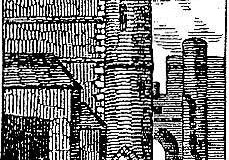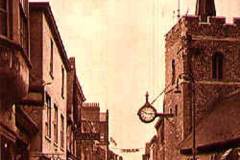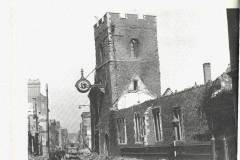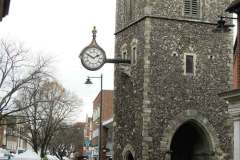The original St George’s church dated back to Norman times, but the present tower is probably 15th century. The church contained an ornate octagonal font. Canterbury’s most famous son, Christopher Marlowe was baptised in this font in 1564. His parents, John and Catherine, lived in a house almost opposite the church.
A woodcut of the church was created in 1825 (Image 1) showing it without the clock but with the city’s St George’s gate in the background. In 1836 a new clock was constructed on the south side of the tower and it was some 30 years later that the church was extended to accommodate the parishioners of the adjacent parish of St Mary Magdalene when that church, apart from its tower that remains, was demolished as it was unsafe. The St George’s church, its tower and the clock must have been the main feature of this part of the High Street (Image 2) .
On the night of 1st June 1942 Canterbury suffered its worst bombing raid of World War II. The Marlowes’ house, the church and almost every building in this area of the City was destroyed or seriously damaged. The shell of the church remained for 10 years (Image 3) before all but the tower of the church was demolished. The tower and its clock are all that remain of this part of the medieval city (Image 4). To see a drawing by local artist Joan Russell of St George’s Church in 1943 click here.
Access: on a public road
AT




